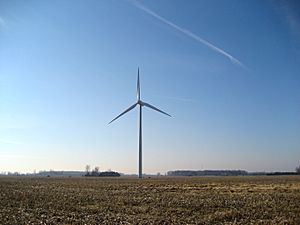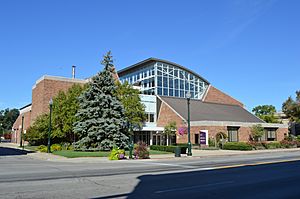Bowling Green, Ohio facts for kids
Quick facts for kids
Bowling Green, Ohio
|
|||||
|---|---|---|---|---|---|
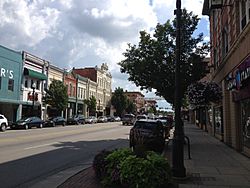
Downtown Bowling Green, Ohio as seen from the intersection of Main St. and Wooster St.
|
|||||
|
|||||
| Nicknames:
BG, Pull Town, USA
|
|||||
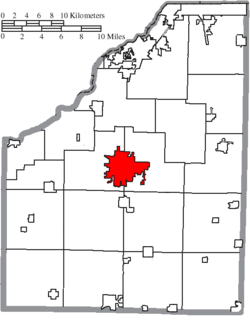
Location of Bowling Green in Wood County
|
|||||
| Country | United States | ||||
| State | Ohio | ||||
| County | Wood | ||||
| Incorporated | 1901 | ||||
| Government | |||||
| • Type | "Mayor-Administrator" | ||||
| Area | |||||
| • Total | 12.91 sq mi (33.44 km2) | ||||
| • Land | 12.86 sq mi (33.32 km2) | ||||
| • Water | 0.05 sq mi (0.12 km2) 0.40% | ||||
| Elevation | 689 ft (210 m) | ||||
| Population
(2020)
|
|||||
| • Total | 30,808 | ||||
| • Estimate
(2023)
|
30,384 | ||||
| • Density | 2,395.09/sq mi (924.72/km2) | ||||
| Time zone | UTC-5 (EST) | ||||
| • Summer (DST) | UTC-4 (EDT) | ||||
| Zip code |
43402 & 43403
|
||||
| Area code(s) | 419, 567 | ||||
| FIPS code | 39-07972 | ||||
| GNIS feature ID | 1087179 | ||||
| Website | https://www.bgohio.org | ||||
Bowling Green is a city in Ohio, located about 20 miles (32 km) southwest of Toledo. It is the main city of Wood County and home to Bowling Green State University. In 2020, about 30,808 people lived here. Bowling Green is part of the larger Toledo area.
Contents
A Look Back in Time
How Bowling Green Started
Bowling Green was first settled in 1832. It became a town in 1855 and then a city in 1901. The village was named after Bowling Green, Kentucky, by a postal worker who used to deliver mail there.
Growth and Oil Boom
In 1868, Bowling Green was chosen as the county seat, taking over from Perrysburg. The city grew a lot when oil was discovered nearby in the late 1800s and early 1900s. This brought a lot of money to the area. You can still see the results of this wealth in the old buildings downtown and along Wooster Street, where many large, old homes were built. A new county courthouse was also built in the 1890s, and a beautiful post office was finished in 1913.
Later Years
After the oil boom, the automobile industry expanded. A car company moved to Bowling Green in the early 1920s, hiring many workers. However, the car industry later became centered in Detroit, Michigan, and the company closed.
During World War II, some people who were held as prisoners of war helped work at the Heinz Tomato Ketchup factory in town. This factory closed in 1975.
In 2001, a runaway freight train carrying dangerous liquids passed through Bowling Green. It traveled over 65 miles (105 km) before a brave railroad worker managed to stop it near Kenton. Luckily, no one was hurt and nothing was damaged.
Where is Bowling Green?
Bowling Green is located in an area that was once a huge swamp called the Great Black Swamp. This swamp was drained in the 1800s, leaving behind very rich soil that is great for farming.
The city covers about 12.61 square miles (32.66 square kilometers). Most of this area is land, with a small amount of water. Bowling Green is in the northwestern part of Ohio.
Climate
Bowling Green has a climate with warm summers and cold winters. The hottest month is usually July, and the coldest is January. It gets rain throughout the year and some snow in winter.
People of Bowling Green
| Historical population | |||
|---|---|---|---|
| Census | Pop. | %± | |
| 1870 | 906 | — | |
| 1880 | 1,539 | 69.9% | |
| 1890 | 3,467 | 125.3% | |
| 1900 | 5,067 | 46.1% | |
| 1910 | 5,222 | 3.1% | |
| 1920 | 5,788 | 10.8% | |
| 1930 | 6,688 | 15.5% | |
| 1940 | 7,190 | 7.5% | |
| 1950 | 12,005 | 67.0% | |
| 1960 | 13,574 | 13.1% | |
| 1970 | 21,760 | 60.3% | |
| 1980 | 25,745 | 18.3% | |
| 1990 | 28,176 | 9.4% | |
| 2000 | 29,636 | 5.2% | |
| 2010 | 30,028 | 1.3% | |
| 2020 | 30,808 | 2.6% | |
| 2023 (est.) | 30,384 | 1.2% | |
| U.S. Decennial Census | |||
In 2010, there were about 30,028 people living in Bowling Green. The city had 11,288 households. The average age of people in the city was 23.2 years old. Many young people live here because of the university.
Economy and Energy
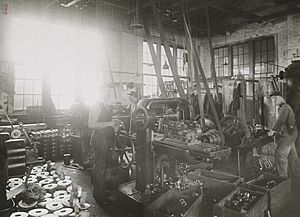
A company called Lubrizol has a factory in Bowling Green that makes soap and cleaning products. This factory opened in 1994 and has grown since then.
Wind Power
Bowling Green is home to Ohio's first large wind farm. It's located just west of the city. There are four tall wind turbines, each about 257 feet (78 meters) high. These turbines create enough electricity to power about 3,000 homes. They can be seen from far away and have become a local landmark. At the site, a solar-powered information stand tells visitors about the wind speed and how much energy the turbines are making.
Culture and Fun
The Black Swamp Arts Festival is a popular event held every year in Bowling Green. It's a free festival that celebrates art and live music. It usually takes place on the first full weekend after Labor Day. The festival aims to connect art with the community and promote the arts in Bowling Green.
Learning and Education
Schools for Kids
Bowling Green has several public elementary schools, including Kenwood, Conneaut, and Crim Elementary. There are also private schools like Bowling Green Christian Academy and the Montessori School of Bowling Green. St. Aloysius is a Catholic school. For older students, there's Bowling Green Middle School and Bowling Green Senior High School.
University Life
Bowling Green State University is a big university located on the northeast side of the city. As of September 2020, it had over 20,000 students.
Public Library
Bowling Green is home to the main branch of the Wood County District Public Library. It's a great place to find books, learn, and use computers.
News and Media
Bowling Green has several ways for people to get their news and entertainment:
- Newspapers: Sentinel Tribune, The BG News, and BG Independent Media.
- Radio Stations: WBGU 88.1 FM, WFAL Falcon Radio, WRQN, WJYM 730 AM, and WWOC-LP 97.7 FM.
- Television: WBGU-PBS.
Getting Around
The city offers a public bus service called B.G. Transit. Bowling Green State University also has its own shuttle buses that run around campus and downtown.
For those who enjoy biking or walking, there's a 13-mile (21 km) rail trail called the Slippery Elm Trail. It connects Bowling Green to North Baltimore. A CSX train line also runs through the city.
Famous People From Bowling Green
- Alissa Czisny, a figure skater who won U.S. championships.
- Anthony De La Torre, an actor.
- William Easterly, an economist and professor.
- Randy Gardner, a politician in Ohio.
- Scott Hamilton, an Olympic gold medalist in figure skating and TV commentator.
- Chris Hoiles, a retired Major League Baseball player.
- Paul Pope, a comic book writer and artist.
- Andy Tracy, a former baseball player for the Philadelphia Phillies.
- Dave Wottle, an Olympic gold medalist runner.
See also
 In Spanish: Bowling Green (Ohio) para niños
In Spanish: Bowling Green (Ohio) para niños






